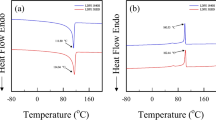Abstract
Mechanical and thermal properties of Roma Plastilina Clay #1 (RP1) were studied through small-amplitude oscillatory shear (SAOS), large-amplitude oscillatory shear (LAOS), and differential scanning calorimetry (DSC), supplemented with thermogravimetric analysis, X-ray diffraction, and X-ray florescence. Rheological characterizations of RP1 through SAOS indicate that the clay composite softens as it is worked and slowly stiffens as it rests. Upon heating, the clay composite softens, prior work history is erased, and the composite undergoes a melting transition, although melted clay is significantly stiffer when returned to the usage temperature. Continuing mechanical characterizations into the LAOS or nonlinear region, RP1 transitions from a transient network to a viscous shear-thinning material as the temperature is increased. Using the MITlaos framework, RP1 exhibits intra-cycle strain stiffening and intra-cycle shear thinning at all temperatures.











Similar content being viewed by others
Notes
Certain commercial equipment, instruments, or materials are identified in this paper in order to specify the experimental procedure adequately. Such identification is not intended to imply recommendation or endorsement by the National Institute of Standards and Technology, nor is it intended to imply that the materials or equipment identified are necessarily the best available for the purpose.
References
Prather RN, Swann CL, Hawkins CE (1977) Backface signatures of soft body armors and the associated trauma effects. Techniacl report, army armament research and development command, Aberdeen Proving Ground
Lehowicz LG, Gupta YM, Killinger DK, Markov VB, McGuffin-Cawley JD, Smith HI, Walker KL, Wiederhorn SM, Wilson AG (2009) Phase I report on review of the testing of body armor materials for use by the U.S. army: letter report, The National Academies Press
Lehowicz LG, Denn MM, Fahrenholtz WG, Ronald D Fricker J, McGuffin-Cawley JD, Smith HI, Walker KL, Wilson AG (2010) Testing of body armor materials for use by the U.S. army-phase II: letter report, The National Academies Press
Lehowicz LG, Bass CR, Budinger TF, Denn MM, Fahrenholtz WG, Ronald D Fricker J, Gupta YM, Killinger DK, Markov VB, McGuffin-Cawley JD, Prather RN, Wiederhorn SM, Wilson AG (2012) Testing of body armor materials: phase III. The National Academies Press
Hanlon E, Gillich P (2012) Origin of the 44-mm behind-armor blunt trauma standard. Mil Med 177(3):333–339
Cavallaro PV (2011) Soft body armor: An overview of materials, manufacturing, testing, and ballistic impact dynamics. Technical report, naval undersea warfare center division, Newport
Giesel F (1878) Plastilina. Deut Chem Ges Ber 11:310
Macosko C (1994) Rheology: principles, measurements, and applications., Advances in interfacial engineering series Wiley, Poughkeepsie
Dealy J, Larson R (2006) Structure and Rheology of molten polymers: from structure to flow behavior and back again. Hanser Publishers, Munich
Morrison F (2001) Understanding rheology., A series of textbooks and monographs. Topics chemical engineering Oxford University Press, New York
Hyun K, Kim SH, Ahn KH, Lee SJ (2002) Large amplitude oscillatory shear as a way to classify the complex fluids. J Non-Newton Fluid Mech 107:51–65
Hyun K, Wilhelm M, Klein CO, Cho KS, Nam JG, Ahn KH, Lee SJ, Ewoldt RH, McKinley GH (2011) A review of nonlinear oscillatory shear tests: analysis and application of large amplitude oscillatory shear (LAOS). Prog Polym Sci 36:1697–1753
Rogers SA, Erwin BM, Vlassopoulos D, Cloitre M (2011) A sequence of physical processes determined and quantified in LAOS: application to a yield stress fluid. J Rheol 55(2):435–458
Rogers SA, Lettinga MP (2012) A sequence of physical processes determined and quantified in large-amplitude oscillatory shear (LAOS): application to theoretical nonlinear models. J Rheol 56(1):1–25
Rogers SA (2012) A sequence of physical processes determined and quantified in LAOS: an instantaneous local 2D/3D approach. J Rheol (1978-present) 56(5):1129–1151
Wilhelm M, Maring D, Spiess HW (1998) Fourier-transform rheology. Rheol Acta 37(4):399–405
Wilhelm M, Reinheimer P, Ortseifer M (1999) High sensitivity fourier-transform rheology. Rheol Acta 38(4):349–356
Wilhelm M, Reinheimer P, Ortseifer M, Neidhfer T, Spiess HW (2000) The crossover between linear and non-linear mechanical behaviour in polymer solutions as detected by Fourier-transform rheology. Rheol Acta 39(3):241–246
Ewoldt RH, Hosoi AE, McKinley GH (2008) New measures for characterizing nonlinear viscoelasticity in large amplitude oscillatory shear. J Rheol 52(6):1427–1458
Cho KS, Hyun K, Ahn KH, Lee SJ (2005) A geometrical interpretation of large amplitude oscillatory shear response. J Rheol 49(3):747–758
Acknowledgements
Special thanks to S. Leigh, A. Kotula, and A. Forster for reviewing this manuscript.
Author information
Authors and Affiliations
Corresponding author
Additional information
Official contribution of the National Institute of Standards and Technology; not subject to copyright in the United States.
Rights and permissions
About this article
Cite this article
Seppala, J.E., Heo, Y., Stutzman, P.E. et al. Characterization of clay composite ballistic witness materials. J Mater Sci 50, 7048–7057 (2015). https://doi.org/10.1007/s10853-015-9259-7
Received:
Accepted:
Published:
Issue Date:
DOI: https://doi.org/10.1007/s10853-015-9259-7




